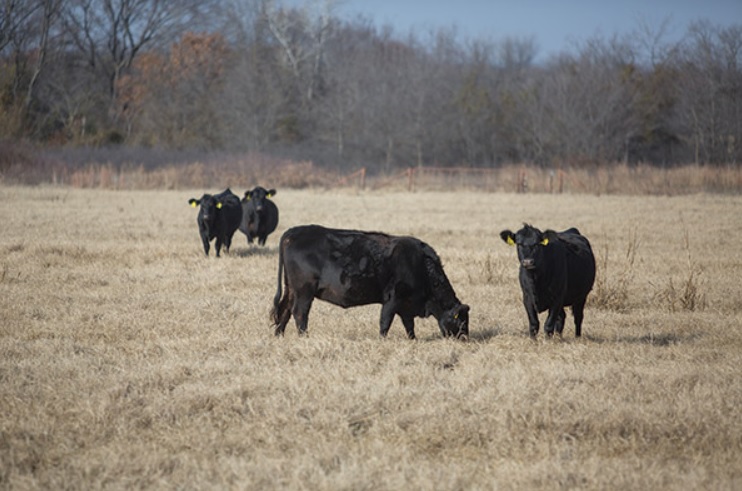
Agricultural News
Noble Foundation Finds Proper Management Promotes Fall, Winter Grazing
Mon, 12 Oct 2015 15:21:43 CDT

Contributed by The Samuel Roberts Noble Foundation Assistant Professor James Rogers
I have always been fascinated with animal behavior, especially beef cattle on pasture. They are selective grazers always in search for the highest quality forages. This explains why you see areas of lush pasture go ungrazed in pastures with light stocking rates and high forage availability. Even when we increase stocking rates up to mob grazing levels (1 million pounds of stock per acre), cattle still selectively graze. I've witnessed stocker cattle at a stock density of slightly over a million pounds per acre be turned into a fresh paddock of native range in late June, quickly consume Basketflower flower heads, strip leaves off johnsongrass and tall native grasses, and trample remaining mature forage. Then they look at us begging to go to another paddock. We tested Basketflower flower heads; crude protein (CP) was 17 percent and total digestible nutrient (TDN) level was 72 percent. Samples from the paddock were tested for nutritive value prior to grazing; on average, CP was 8.4 percent and TDN was 54 percent. Fecal samples collected from the cattle during grazing had an average CP of 11 percent and TDN of 65 percent. Obviously, the cattle knew what they were doing. The problem was forage quality availability, and they just could not consume enough of what they wanted to consume to meet intake demands, and consequently protein and energy requirements, for a high daily gain.
This helps illustrate the problem we encounter with fall and winter grazing of perennial forages: forage quality availability vs. forage availability. If stocking rate is estimated based on a 12 month carrying capacity then, by grazing management and forage deferment, excess forage can accumulate for use after the growing season ends. The problem is that carryover forage from early in the growing season is low in forage nutritive value, but availability may be very good. For example, in December 2014 I tested several paddocks of bermudagrass that consisted of carryover spring growth. Forage availability was excellent, slightly below 5,000 pounds of dry matter per acre, but the average CP value was 5.52 percent and TDN was 57.34 percent. I would expect cows grazing this type of forage to behave very similar to the steers on native range discussed previously. Cattle would quickly select for the highest quality, trample the rest and look for somewhere else to go. It should also be noted that a supplement would be required to maintain body condition. Quality stockpile forage is fresh fall growth; if stockpiled from fresh, fertilized fall growth, bermudagrass can have crude protein values in excess of 10 percent (Oklahoma Cooperative Extension Service ANSI-3035). If you are in an area where tall fescue grows well, it too can have very good nutritive value well into late fall and early winter (University of Kentucky Cooperative Extension Service AGR-162).
Now, how are you and your cows going to use accumulated forage for fall and winter grazing? Consider how well stockpile forage will resist decomposition through fall and winter to determine order of grazing. Since cattle selectively graze, utilization of stockpiled forages may be lower than what the book values tell you. Keep this in mind as you manage both forage and cow condition. What appears to you as knee-deep abundant forage may appear to a cow as a pile of pulpwood.
All accumulated or stockpiled forages will lose dry matter following frost and through winter. The rate this occurs varies by species composition. Of the Southern Great Plains forages, a grazing order could be crabgrass, old world bluestems (OWB), native grass, bermudagrass and tall fescue. Take advantage of crabgrass early as it will rapidly deteriorate following a frost and you will not be able to graze it for very long. Old world bluestem is next. Nutritive value will be low and utilization will be low, and don't expect to spend a lot of time on OWB following frost without cattle losing condition. Next is a toss-up between native grass and bermudagrass. Native grass stands well following frost but lower leaves will deteriorate and nutritive value will be low, which is why I try to use it ahead of bermudagrass. Cattle on standing native grass will leave stems behind or trampled. Native grass that is stockpiled for multiple years in a row will begin to have cool-season grasses develop in the sward over time. These cool-season grasses can be used in late winter and early spring to keep them from competing with native grass spring green-up. For this reason, I tend to recommend using a different area of native range for stockpile each year. Bermudagrass stockpiles well and can have very good quality (greater than 10 percent CP) if fertilized in the fall. Following frost, leaves will become brittle and leaf losses will occur as cattle move through. In areas where it is adapted, tall fescue stockpiles the best of the forages mentioned here. Its waxy leaves maintain quality through the winter, so its use can be delayed until other forages have been used. There will not be major nutritional value losses, though some dry matter losses will occur.
Fine-tune your grazing management by taking an inventory of forage mass and grab samples for forage nutritive value. Expect animal behavior and performance differences between carryover spring forage and true fall stockpile forage. All of these forages will more than likely require some type of supplementation to meet animal nutritive requirements, but these can be based from the grab samples. Monitor cow body condition while on stockpile and make feeding adjustments as necessary.
References:
Managing bermudagrass pasture to reduce winter hay feeding in beef cattle operations. Oklahoma Cooperative Extension Fact Sheet ANSI-3035.
Stockpiling for fall and winter pasture, University of Kentucky Cooperative Extension Service. AGR-162.
WebReadyTM Powered by WireReady® NSI
Top Agricultural News
More Headlines...



















